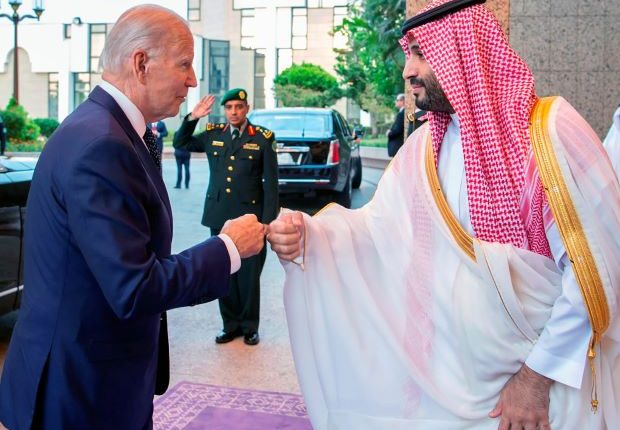Biden starts his first visit to Saudi Arabia as president
By David E. Sanger, Peter Baker and Ben Hubbard
JEDDAH – President Joe Biden used his visit to Israel this week to bolster the blossoming relationship between Israel and a handful of Arab states. But it is Biden’s own relationship with Saudi Arabia that looms largest over the second part of his four-day trip, and the kingdom’s welcome of him was being closely watched as an indication of how the overall visit might unfold.
As Air Force One landed, just before 6:00 p.m. local time, the Saudi reception, while led by a senior member of the royal family, was decidedly lacking in pomp. Lining the lilac carpet were a small number of uniformed security officers bearing swords, but even fewer than were dispatched to welcome President Barack Obama when he arrived in the kingdom to a chilly reception in 2016.
Biden emerged from the plane and made his way down the stairs for his first visit to Saudi Arabia as president, wearing his aviator shades, waving and looking serious. He was greeted by Princess Reema bint Bandar, the Saudi ambassador to Washington, and Prince Khalid bin Faisal, a senior member of the royal family who is the governor of Mecca and is close to King Salman.
The president climbed into his limousine just two minutes after disembarking. He was taken directly to meet Salman, with no photographers present at the meeting.
Arriving at Al-Salam Palace, Biden was met by Crown Prince Mohammed and the two exchanged an apparently wordless fist bump before the crown prince led the president inside. The Saudi-owned Al-Arabiya satellite channel broadcast images of Biden being warmly welcomed by King Salman, and shaking his hand. Other images showed Biden and the king sitting next to each other in armchairs in an ornate room during a meeting, with other US and Saudi officials, including Crown Prince Mohammed, sitting nearby.
Biden was set to hold a “working session” along with his team with Crown Prince Mohammed and various Saudi ministers later in the day.
Biden’s arrival in Saudi Arabia was polite but perfunctory compared with the enthusiastic greeting President Donald Trump received in 2017 when King Salman welcomed him on the tarmac. Trump made Saudi Arabia his first overseas destination as president, a sharp break with tradition and a sign of how closely he would align his administration with the Saudis.
Biden and his aides, by contrast, had been dreading any image of the president meeting with Crown Prince Mohammed, who was deemed responsible for the brutal 2018 killing in Istanbul of Jamal Khashoggi, a Saudi dissident and columnist for The Washington Post who was living in the United States.
The president’s aides even suggested Wednesday (13) before he landed in Israel that Biden would avoid handshakes during his trip, ostensibly because of the rapidly spreading new coronavirus subvariant — although within minutes of arriving, he dispensed with any such policy and shook hands with two former Israeli prime ministers.
Even though Biden vowed as a candidate to punish Saudi Arabia over Khashoggi’s murder by making the kingdom a “pariah,” the president decided that it was worth the political cost of traveling there this week to counter Chinese influence, press for additional oil production and encourage closer ties with Israel.
In other cases, recently including Cuba and Venezuela, Biden has stressed that his administration is making democracy and respect for human rights the paramount consideration for dealing with other nations’ leaders. But on Thursday (14) in Jerusalem, he said he was going to Saudi Arabia to promote US interests.
Those include getting the kingdom to pump more oil from its somewhat modest spare capacity.
-New York Times


